Combined Action of Antibiotics and Bacteriocins against Vancomycin-Resistant Enterococci
Abstract
:1. Introduction
2. Materials and Methods
2.1. Differentiation and Identification of VRE Strains and Detection of the Type of Vancomycin Resistance
2.2. Screening for Bacteriocins Effective against VRE Strains
2.3. Partial Purification of the Bacteriocins
2.4. Determination of MIC for Vancomycin, Other Antibiotics, and Semi-Purified Bacteriocins for Enterococcus faecium Strains VRE 9, 18, 19, and 23
2.5. Evaluation of Proportions between Resistant and Susceptible Mutants in the Population of the VRE Strains
2.6. Effect of Individual and Combined Application of Bacteriocin and Antibiotics on VRE Strains
2.7. Fluorescent In Situ Hybridization
2.8. FLOW Cytometry Analysis
2.9. Virulence Genes in VRE
2.10. Determining the Changes in the MIC after Exposure to Low Concentrations of Bacteriocin
3. Results and Discussion
3.1. Differentiation and Identification of VRE Strains and Detection of the Type of Vancomycin Resistance
3.2. Virulence Genes in Enterococcus faecium Strains VRE 8, 18, 19, and 23
3.3. Screening for Bacteriocins Effective against VRE Strains
3.4. Partial Purification of the Bacteriocins
3.5. Determination of MIC for Vancomycin and Semi-Purified Bacteriocins against Selected VRE Strains
3.6. Effect of Bactriocins, Dead, Resistant, and Susceptible Strains in the Population of the Studied VRE Strains
3.7. Effect of Individual and Combined Application of Bacteriocin and Vancomycin on VRE
3.8. Following the Changes in the MICs after Exposure to Low Concentrations of Bacteriocin
4. Conclusions
Author Contributions
Funding
Institutional Review Board Statement
Informed Consent Statement
Data Availability Statement
Acknowledgments
Conflicts of Interest
References
- Murray, C.J.; Ikuta, K.S.; Sharara, F.; Swetschinski, L.; Aguilar, G.R.; Gray, A.; Han, C.; Bisignano, C.; Rao, P.; Wool, E.; et al. Global burden of bacterial antimicrobial resistance in 2019: A systematic analysis. Lancet 2022, 399, 629–655. [Google Scholar] [CrossRef]
- Petrovich, M.L.; Zilberman, A.; Kaplan, A.; Eliraz, G.R.; Wang, Y.; Langenfeld, K.; Duhaime, M.; Wigginton, K.; Poretsky, R.; Avisar, D.; et al. Microbial and viral communities and their antibiotic resistance genes throughout a hospital wastewater treatment system. Front. Microbiol. 2020, 11, 153. [Google Scholar] [CrossRef] [PubMed] [Green Version]
- Zhuang, M.; Achmon, Y.; Cao, Y.; Liang, X.; Chen, L.; Wang, H.; Siame, B.A.; Leung, K.Y. Distribution of antibiotic resistance genes in the environment. Environ. Pollut. 2021, 285, 117402. [Google Scholar] [CrossRef] [PubMed]
- World Health Organization. Global Priority List of Antibiotic-Resistant Bacteria to Guide Research, Discovery, and Development of New Antibiotics. 2017. Available online: https://www.who.int/medicines/publications/WHO-PPL-Short_Summary_25Feb-ET_NM_WHO.pdf (accessed on 31 January 2022).
- Chikindas, M.L.; Weeks, R.; Drider, D.; Chistyakov, V.A.; Dicks, L.M. Functions and emerging applications of bacteriocins. Curr. Opin. Biotechnol. 2018, 49, 23–28. [Google Scholar] [CrossRef]
- Pircalabioru, G.G.; Popa, L.; Marutescu, L.; Gheorghe, I.; Popa, M.; Barbu, I.C.; Cristescu, R.; Chifiriuc, M.-C. Bacteriocins in the era of antibiotic resistance: Rising to the challenge. Pharmaceuticals 2021, 13, 196. [Google Scholar] [CrossRef]
- Todorov, S.D.; Franco, B.D.G.M.; Tagg, J.R. Bacteriocins of Gram-positive bacteria having activity spectra extending beyond closely-related species. Benef. Microbes 2019, 10, 315–328. [Google Scholar] [CrossRef]
- Mills, S.; Ross, R.P.; Hill, C. Bacteriocins and bacteriophage; a narrow-minded approach to food and gut microbiology. FEMS Microbiol. Rev. 2017, 41 (Suppl. S1), S129–S153. [Google Scholar] [CrossRef]
- Soltani, S.; Hammami, R.; Cotter, P.D.; Rebuffat, S.; Said, L.B.; Gaudreau, H.; Bédard, F.; Biron, E.; Drider, D.; Fliss, I. Bacteriocins as a new generation of antimicrobials: Toxicity aspects and regulations. FEMS Microbiol. Rev. 2020, 45, fuaa039. [Google Scholar] [CrossRef]
- Favaro, L.; Penna, A.B.; Todorov, S. Bacteriocinogenic LAB from cheeses—Application in biopreservation? Trends Food. Sci. Technol. 2015, 41, 37–48. [Google Scholar] [CrossRef]
- Mokoena, M.; Omatola, C.; Olaniran, A. Applications of lactic acid bacteria and their bacteriocins against food spoilage microorganisms and foodborne pathogens. Molecules 2021, 26, 7055. [Google Scholar] [CrossRef]
- Aguilar-Pérez, C.; Gracia, B.; Rodrigues, L.; Vitoria, A.; Cebrián, R.; Deboosère, N.; Song, O.-R.; Brodin, P.; Maqueda, M.; Aínsa, J.A. Synergy between circular bacteriocin AS-48 and ethambutol against Mycobacterium tuberculosis. Antimicrob. Agents Chemother. 2018, 62, e00359-18. [Google Scholar] [CrossRef] [PubMed] [Green Version]
- Okuda, K.-I.; Zendo, T.; Sugimoto, S.; Iwase, T.; Tajima, A.; Yamada, S.; Sonomoto, K.; Mizunoe, Y. Effects of Bacteriocins on Methicillin-Resistant Staphylococcus aureus Biofilm. Antimicrob. Agents Chemother. 2013, 57, 5572–5579. [Google Scholar] [CrossRef] [PubMed] [Green Version]
- Phumisantiphong, U.; Siripanichgon, K.; Reamtong, O.; Diraphat, P. A novel bacteriocin from Enterococcus faecalis 478 exhibits a potent activity against vancomycin-resistant enterococci. PLoS ONE 2017, 12, e0186415. [Google Scholar] [CrossRef] [PubMed] [Green Version]
- Fugaban, J.; Vazquez Bucheli, J.E.; Holzapfel, W.H.; Todorov, S.D. Characterization of partially purified bacteriocins produced by Enterococcus faecium strains isolated from soybean paste active against Listeria spp. and vancomycin-resistant enterococci. Microorganisms 2021, 9, 1085. [Google Scholar] [CrossRef]
- Valledor, S.J.D.; Dioso, C.M.; Bucheli, J.E.V.; Park, Y.J.; Suh, D.H.; Jung, E.S.; Kim, B.; Holzapfel, W.H.; Todorov, S.D. Characterization and safety evauation of two beneficial, enterocin-producing Enterococcus faecium strains isolated from kimchi, a Korean fermented cabbage. Food Microbiol. 2022, 102, 103886. [Google Scholar] [CrossRef] [PubMed]
- Montalbán-López, M.; Cebrián, R.; Galera, R.; Mingorance, L.; Martín-Platero, A.; Valdivia, E.; Martínez-Bueno, M.; Maqueda, M. Synergy of the bacteriocin AS-48 and antibiotics against uropathogenic Enterococci. Antibiotics 2020, 9, 567. [Google Scholar] [CrossRef]
- Heilbronner, S.; Krismer, B.; Brötz-Oesterhelt, H.; Peschel, A. The microbiome-shaping roles of bacteriocins. Nat. Rev. Microbiol. 2021, 19, 726–739. [Google Scholar] [CrossRef]
- Valledor, S.J.D.; Bucheli, J.E.V.; Holzapfel, W.H.; Todorov, S.D. Exploring beneficial properties of the bacteriocinogenic Enterococcus faecium ST10Bz strain isolated from boza, a Bulgarian cereal-based beverage. Microorganisms 2020, 8, 1474. [Google Scholar] [CrossRef]
- Vos, P.D.; Garrity, G.M.; Jones, D.; Krieg, N.R.; Ludwig, W.; Rainey, F.A.; Schleifer, K.-H.; Whitman, W.B.; Parte, A.C.; Michael, G.; et al. Bergeys Manual of Systematic Bacteriology: The Firmicutes; Springer: London, UK, 2009. [Google Scholar]
- dos Santos, K.M.O.; de Matos, C.R.; Salles, H.O.; Franco, B.D.G.D.M.; Arellano, K.; Holzapfel, W.H.; Todorov, S.D. Exploring beneficial/virulence properties of two dairy-related strains of Streptococcus infantarius subsp. infantarius. Probiotics Antimicrob. Proteins 2020, 12, 1524–1541. [Google Scholar] [CrossRef]
- Todorov, S.; Onno, B.; Sorokine, O.; Chobert, J.; Ivanova, I.; Dousset, X. Detection and characterization of a novel antibacterial substance produced by Lactobacillus plantarum ST31 isolated from sourdough. Int. J. Food Microbiol. 1999, 48, 167–177. [Google Scholar] [CrossRef]
- EFSA (European Food Safety Authority) and ECDC (European Centre for DiseasePrevention and Control). The European Union summary report on antimicrobial resistance inzoonotic and indicator bacteria from humans, animals and food in 2017. EFSA J. 2019, 17, 5598. [Google Scholar] [CrossRef]
- Wiegand, I.; Hilpert, K.; Hancock, R.E.W. Agar and broth dilution methods to determine the minimal inhibitory concentration (MIC) of antimicrobial substances. Nat. Protoc. 2008, 3, 163–175. [Google Scholar] [CrossRef] [PubMed]
- EFSA Panel on Additives and Products or Substances used in Animal Feed (FEEDAP); Guidance on the assessment of bacterial susceptibility to antimicrobials of human and veterinary importance. EFSA J. 2012, 10, 2740. [CrossRef]
- Azevedo, A.S.; Gerola, G.P.; Baptista, J.; Almeida, C.; Peres, J.; Mergulhão, F.J.; Azevedo, N.F. Increased intraspecies diversity in Escherichia coli biofilms promotes cellular growth at the expense of matrix production. Antibiotics 2020, 9, 818. [Google Scholar] [CrossRef]
- Oliveira, R.; Azevedo, A.; Mendes, L. Application of nucleic acid mimics in fluorescence in situ hybridization. Meth. Mol. Biol. 2021, 2246, 69–86. [Google Scholar] [CrossRef]
- Ahmed, M.; Baptiste, K. Vancomycin-Resistant Enterococci: A review of antimicrobial resistance mechanisms and perspectives of human and animal health. Microb. Drug. Resist. 2018, 24, 590–606. [Google Scholar] [CrossRef] [Green Version]
- Suppola, J.P.; Kolho, E.; Salmenlinna, S.; Tarkka, E.; Vuopio-Varkila, J.; Vaara, M. vanA and vanB incorporate into an endemic ampicillin-resistant vancomycin-sensitive enterococcus faecium strain: Effect on interpretation of clonality. J. Clin. Microbiol. 1999, 37, 3934–3939. [Google Scholar] [CrossRef] [Green Version]
- Sivertsen, A.; Pedersen, T.; Larssen, K.W.; Bergh, K.; Rønning, T.G.; Radtke, A.; Hegstad, K. A silenced vanA gene cluster on a transferable plasmid caused an outbreak of vancomycin-variable enterococci. Antimicrob. Agents Chemother. 2016, 60, 4119–4127. [Google Scholar] [CrossRef] [Green Version]
- Hashimoto, Y.; Kita, I.; Suzuki, M.; Hirakawa, H.; Ohtaki, H.; Tomita, H. First report of the local spread of vancomycin-resistant enterococci ascribed to the interspecies transmission of a vanA gene cluster-carrying linear plasmid. mSphere 2020, 5, e00102-20. [Google Scholar] [CrossRef] [Green Version]
- Suvorov, A. What is wrong with enterococcal probiotics? Probiotics Antimicrob. Proteins 2020, 12, 1–4. [Google Scholar] [CrossRef]
- Creti, R.; Imperi, M.; Bertuccini, L.; Fabretti, F.; Orefici, G.; Di Rosa, R.; Baldassarri, L. Survey for virulence determinants among Enterococcus faecalis isolated from different sources. J. Med. Microbiol. 2004, 53, 13–20. [Google Scholar] [CrossRef] [PubMed] [Green Version]
- Willems, R.J.; Homan, W.; Top, J.; van Santen-Verheuvel, M.; Tribe, D.; Manzioros, X.; Gaillard, C.; Vandenbroucke-Grauls, C.M.; Mascini, E.M.; van Kregten, E.; et al. Variant esp gene as a marker of a distinct genetic lineage of vancomycin resistant Enterococcus faecium spreading in hospitals. Lancet 2001, 357, 853–855. [Google Scholar] [CrossRef]
- Padilla, C.; Lobos, O. Virulence, bacterocin genes and antibacterial susceptibility in Enterococcus faecalis strains isolated from water wells for human consumption. SpringerPlus 2013, 2, 43. [Google Scholar] [CrossRef] [Green Version]
- Wiens, J.; Snyder, G.; Finlayson, S.; Mahoney, M.; Celi, L. Potential adverse effects of broad-spectrum antimicrobial exposure in the intensive care unit. Open Forum Infect. Dis. 2017, 5, ofx270. [Google Scholar] [CrossRef] [Green Version]
- Heianza, Y.; Ma, W.; Li, X.; Cao, Y.; Chan, A.T.; Rimm, E.B.; Hu, F.B.; Rexrode, K.M.; Manson, J.E.; Qi, L. Duration and life-stage of antibiotic use and risks of all-cause and cause-specific mortality. Prospective cohort study. Circ. Res. 2020, 126, 364–373. [Google Scholar] [CrossRef] [PubMed]
- Drider, D.; Bendali, F.; Naghmouchi, K.; Chikindas, M.L. Bacteriocins: Not only antibacterial agents. Probiotics Antimicrob. Proteins 2016, 8, 177–182. [Google Scholar] [CrossRef]
- Van Heel, A.; Montalban-Lopez, M.; Kuipers, O. Evaluating the feasibility of lantibiotics as an alternative therapy against bacterial infections in humans. Expert. Opin. Drug. Metabol. Toxicol. 2011, 7, 675–680. [Google Scholar] [CrossRef] [Green Version]
- Fugaban, J.I.I.; Bucheli, J.E.V.; Park, Y.J.; Suh, D.H.; Jung, E.S.; Franco, B.D.G.D.M.; Ivanova, I.V.; Holzapfel, W.H.; Todorov, S.D. Antimicrobial properties of Pediococcus acidilactici and Pediococcus pentosaceus isolated from silage. J. Appl. Microbiol. 2022, 132, 311–330. [Google Scholar] [CrossRef]
- Metivier, A.; Pilet, M.-F.; Dousset, X.; Sorokine, O.; Anglade, P.; Zagorec, M.; Piard, J.-C.; Marlon, D.; Cenatiempo, Y.; Fremaux, C. Divercin V41, a new bacteriocin with two disulphide bonds produced by Carnobacterium divergens V41: Primary structure and genomic organization. Microbiology 1998, 144, 2837–2844. [Google Scholar] [CrossRef] [Green Version]
- Bhugaloo-Vial, P.; Grajek, W.; Dousset, X.; Boyaval, P. Continuous bacteriocin production with high cell density bioreactors. Enzym. Microb. Technol. 1997, 21, 450–457. [Google Scholar] [CrossRef]
- Song, D.; Zhu, M.; Gu, Q. Purification and characterization of plantaricin ZJ5, a new bacteriocin produced by Lactobacillus plantarum ZJ5. PLoS ONE 2014, 9, e105549. [Google Scholar] [CrossRef] [PubMed]
- Surovtsev, V.; Borzenkov, V.; Levchuk, V. Purification of bacteriocins by chromatographic methods. Appl. Biochem. Microbiol. 2015, 51, 881–886. [Google Scholar] [CrossRef]
- Oh, S.; Kim, S.; Worobo, R. Characterization and purification of a bacteriocin produced by a potential probiotic culture, Lactobacillus acidophilus 30SC. J. Dairy Sci. 2000, 83, 2747–2752. [Google Scholar] [CrossRef]
- Aunpad, R.; Na-Bangchang, K. Pumilicin 4, a novel bacteriocin with anti-MRSA and anti-VRE activity produced by newly isolated bacteria Bacillus pumilus strain WAPB4. Curr. Microbiol. 2007, 55, 308–313. [Google Scholar] [CrossRef] [PubMed]
- Abanoz, H.; Kunduhoglu, B. Antimicrobial activity of a bacteriocin produced by Enterococcus faecalis KT11 against some pathogens and antibiotic-resistant bacteria. Korean J. Food Sci. Anim. Res. 2018, 38, 1064–1079. [Google Scholar] [CrossRef] [PubMed] [Green Version]
- Pérez-Ramos, A.; Madi-Moussa, D.; Coucheney, F.; Drider, D. Current knowledge of the mode of action and immunity mechanisms of LAB-bacteriocins. Microorganisms 2021, 9, 2107. [Google Scholar] [CrossRef]
- Bauer, R.; Dicks, L. Mode of action of lipid II-targeting lantibiotics. Int. J. Food Microbiol. 2005, 101, 201–216. [Google Scholar] [CrossRef]
- Woodford, N.; Ellington, M. The emergence of antibiotic resistance by mutation. Clin. Microbiol. Infect. 2007, 13, 5–18. [Google Scholar] [CrossRef] [Green Version]
- Chng, K.R.; Li, C.; Bertrand, D.; Ng, A.H.Q.; Kwah, J.S.; Low, H.M.; Tong, C.; Natrajan, M.; Zhang, M.H.; Xu, L.; et al. Cartography of opportunistic pathogens and antibiotic resistance genes in a tertiary hospital environment. Nat. Med. 2020, 26, 941–951. [Google Scholar] [CrossRef]
- Zhao, X.; Drlica, K. Restricting the selection of antibiotic-resistant mutants: A general strategy derived from fluoroquinolone studies. Clin. Infect. Dis. 2001, 33, S147–S156. [Google Scholar] [CrossRef] [Green Version]
- Cleveland, J.; Montville, T.; Nes, I.; Chikindas, M. Bacteriocins: Safe, natural antimicrobials for food preservation. Int. J. Food Microbiol. 2001, 71, 1–20. [Google Scholar] [CrossRef]
- Todorov, S.; Dicks, L. Bacteriocin production by Pediococcus pentosaceus isolated from marula (Scerocarya birrea). Int. J. Food Microbiol. 2009, 132, 117–126. [Google Scholar] [CrossRef] [PubMed]
- Todorov, S. Diversity of bacteriocinogenic lactic acid bacteria isolated from boza, a cereal-based fermented beverage from Bulgaria. Food Control. 2010, 21, 1011–1021. [Google Scholar] [CrossRef]
- Bastos, M.; Coelho, M.; Santos, O. Resistance to bacteriocins produced by Gram-positive bacteria. Microbiology 2015, 161, 683–700. [Google Scholar] [CrossRef] [PubMed] [Green Version]
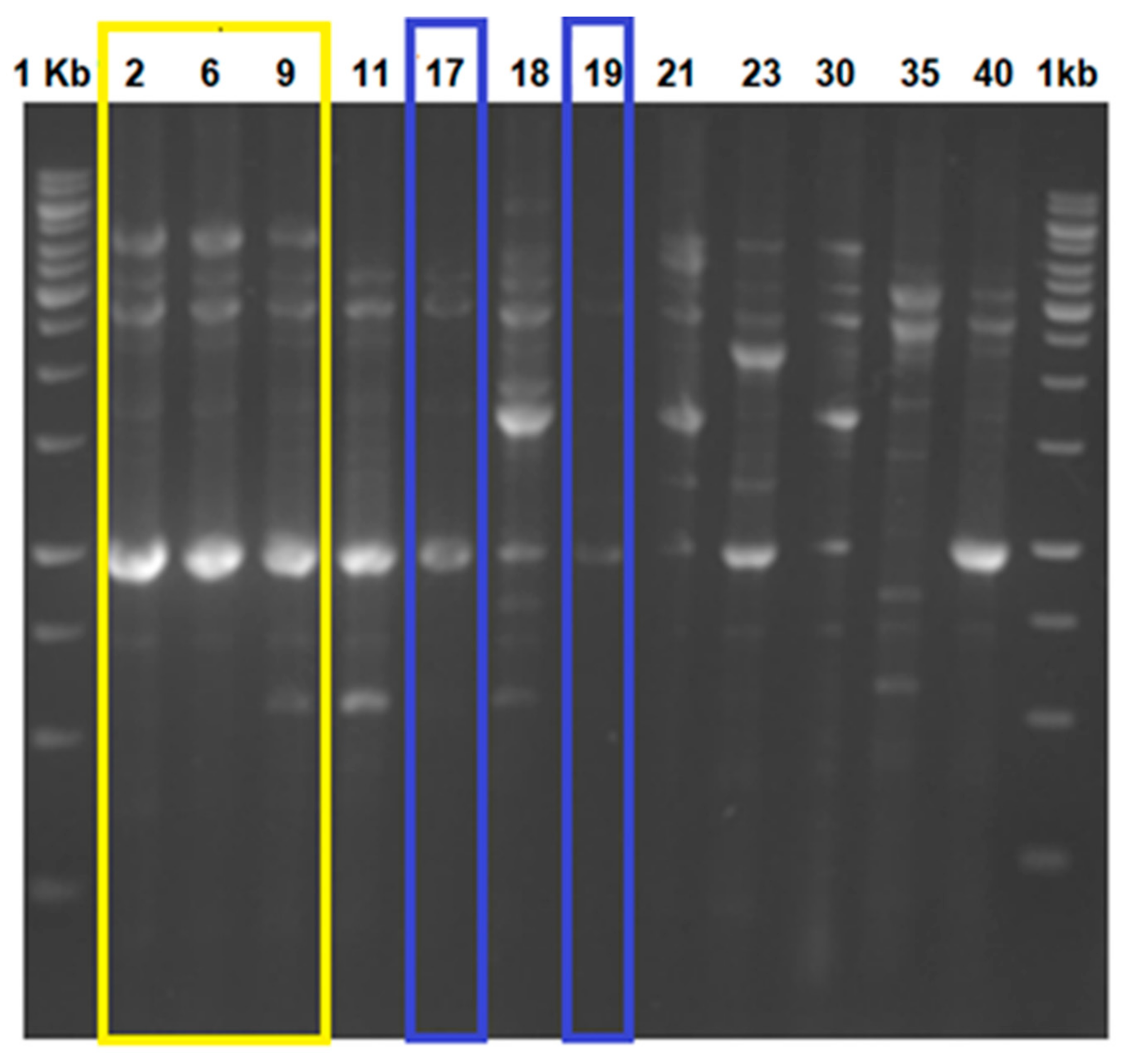

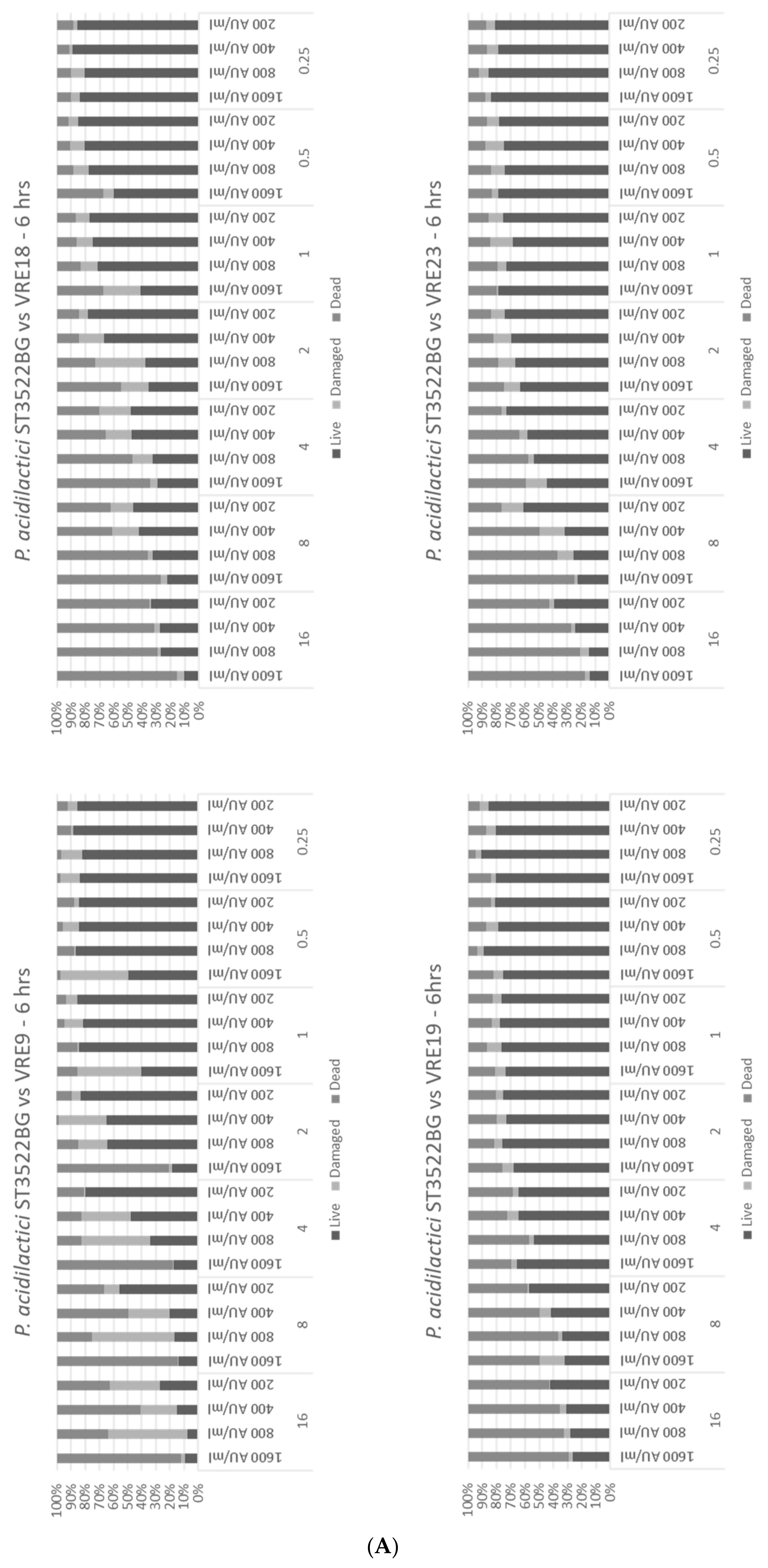
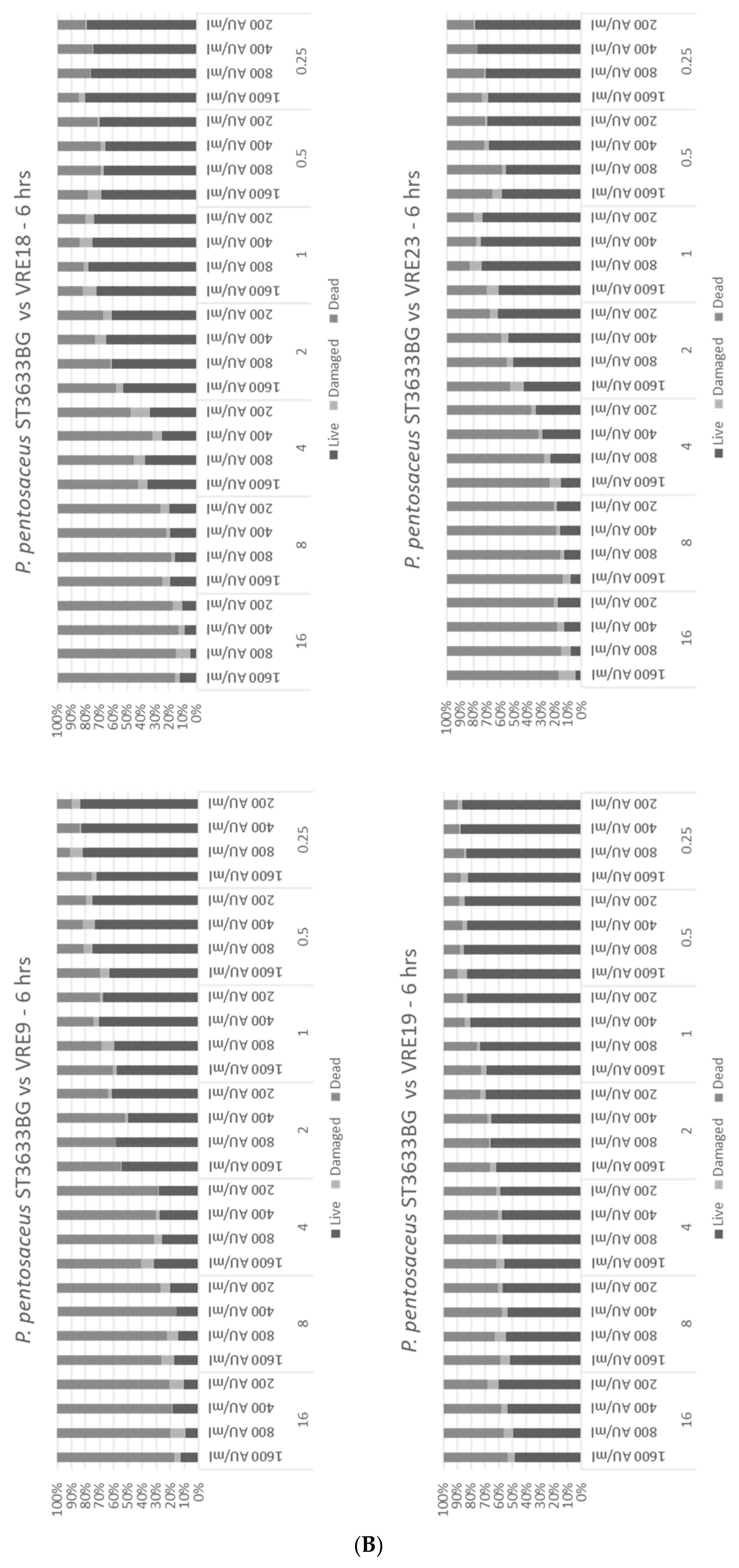
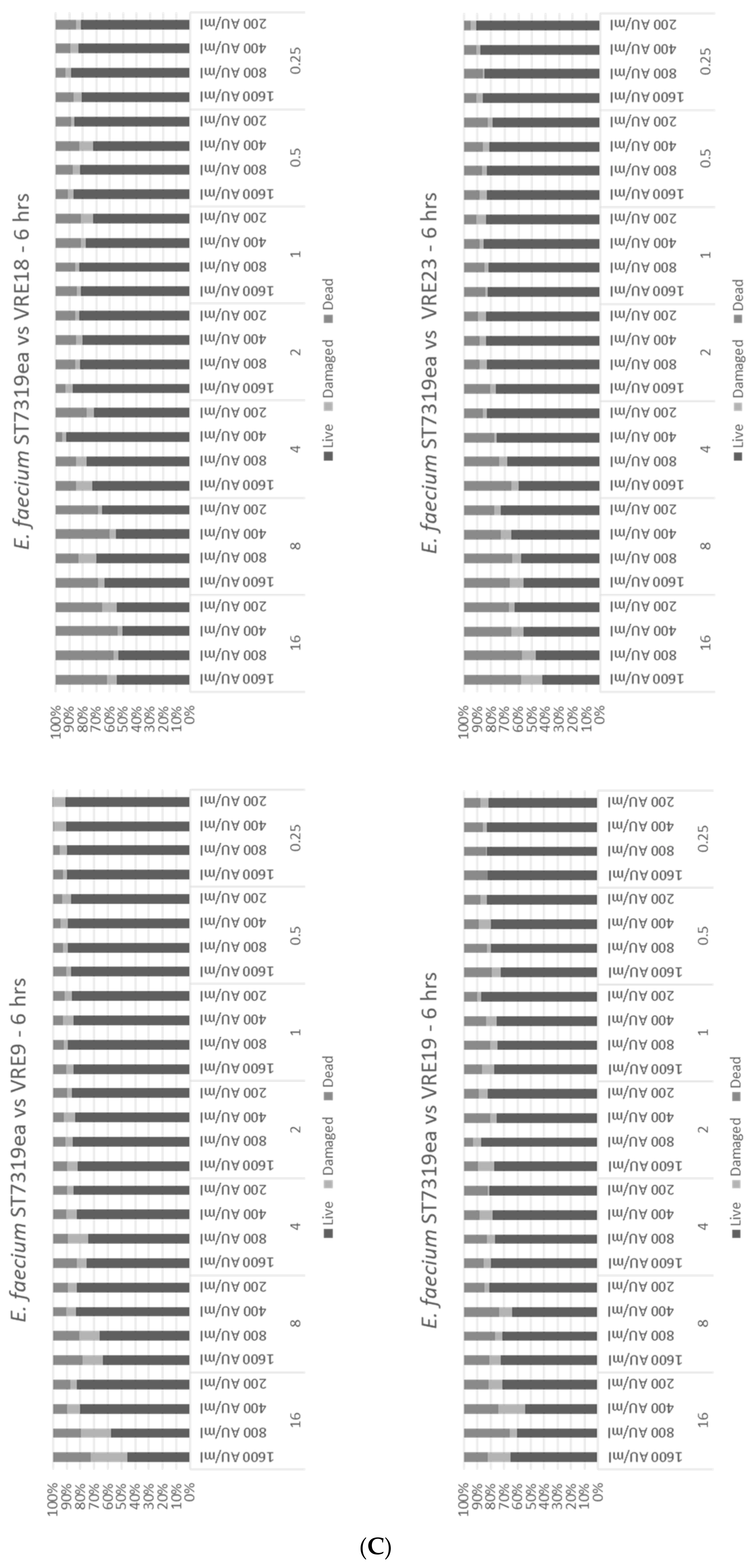


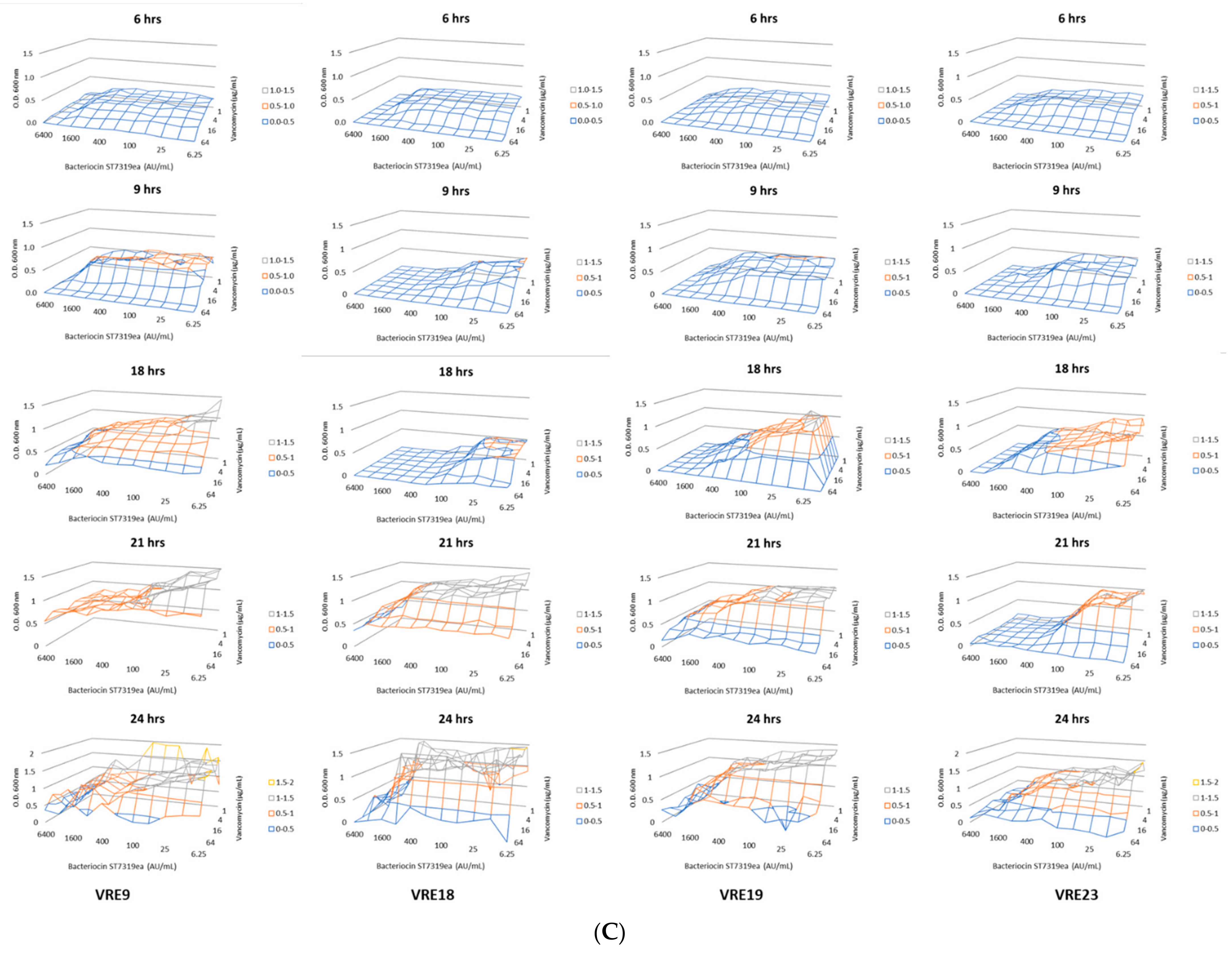
| Species | Strain ID | Bacteriocin (mm Inhibition Zones) | ||||
|---|---|---|---|---|---|---|
| P acidilactici ST3522BG | P. pentosaceus ST3633BG | E. faecium ST7119ea | E. faecium ST651ea | E. faecium ST7319ea | ||
| E. lactis | VRE2 | - | - | - | - | - |
| E. faecium | VRE6 | 14 | 18 | - | - | 6 |
| VRE9 | 15 | 16 | - | - | - | |
| VRE17 | 15 | 16 | 15 | 9 | 9 | |
| VRE21 | 14 | 14 | - | - | - | |
| VRE35 | 12 | 14 | - | - | 6 | |
| VRE40 | 13 | 15 | 11 | 13 | 15 | |
| VRE18 | 14 | 17 | 12 | 14 | 7 | |
| VRE23 | 17 | 19 | 14 | 14 | 15 | |
| VRE11 | 16 | 18 | 16 | 17 | 16 | |
| VRE19 | 15 | 17 | 12 | 14 | 15 | |
| VRE30 | 14 | 15 | 13 | 14 | 14 | |
| L. monocytogenes | ATCC15313 | 14 | 17 | - | 4 | 5 |
| L. innocua | ATCC33090 | 17 | 18 | 15 | 15 | 17 |
| VRE Strain | Ampicillin | Chloramphenicol | Gentamicin | Kanamycin | Vancomycin |
|---|---|---|---|---|---|
| Initial MIC (before Exposure to Sublethal Doses of Bacteriocins) | |||||
| 2 | 128 | 16 | ≥128 | ≥128 | ≥128 |
| 6 | 64 | 2 | ≥128 | 128 | ≥128 |
| 9 | 128 | 4 | ≥128 | ≥128 | ≥128 |
| 11 | 64 | 4 | ≥128 | ≥128 | ≥128 |
| 17 | 64 | 4 | ≥128 | ≥128 | ≥128 |
| 18 | 32 | 8 | ≥128 | ≥128 | ≥128 |
| 19 | 32 | 4 | ≥128 | ≥128 | ≥128 |
| 21 | 32 | 4 | ≥128 | ≥128 | ≥128 |
| 23 | 128 | 32 | ≥128 | ≥128 | ≥128 |
| 30 | 32 | 4 | 16 | 64 | 128 |
| 35 | 64 | 8 | ≥128 | ≥128 | ≥128 |
| 40 | 64 | 8 | 32 | 64 | 64 |
| MIC after Exposure to Bacteriocin Produced by P. acidilactici ST3522BG | |||||
| 9 | 128 | 4 | ≥128 | ≥128 | ≥128 |
| 18 | 32 | 8 | ≥128 | 128 | ≥128 |
| 19 | 32 | 4 | ≥128 | ≥128 | ≥128 |
| 23 | 128 | 16 | ≥128 | 128 | ≥128 |
| MIC after exposure to bacteriocin produced by P. pentosaceus ST3633BG | |||||
| 9 | 128 | 4 | ≥128 | 128 | ≥128 |
| 18 | 32 | 8 | ≥128 | ≥128 | ≥128 |
| 19 | 32 | 4 | ≥128 | ≥128 | ≥128 |
| 23 | 128 | 16 | ≥128 | 128 | ≥128 |
| MIC after exposure to bacteriocin produced by E. faecium ST7319ea | |||||
| 9 | 128 | 4 | ≥128 | ≥128 | ≥128 |
| 18 | 32 | 8 | ≥128 | ≥128 | ≥128 |
| 19 | 32 | 4 | ≥128 | 128 | ≥128 |
| 23 | 128 | 8 | ≥128 | 128 | ≥128 |
Publisher’s Note: MDPI stays neutral with regard to jurisdictional claims in published maps and institutional affiliations. |
© 2022 by the authors. Licensee MDPI, Basel, Switzerland. This article is an open access article distributed under the terms and conditions of the Creative Commons Attribution (CC BY) license (https://creativecommons.org/licenses/by/4.0/).
Share and Cite
Bucheli, J.E.V.; Fugaban, J.I.I.; Holzapfel, W.H.; Todorov, S.D. Combined Action of Antibiotics and Bacteriocins against Vancomycin-Resistant Enterococci. Microorganisms 2022, 10, 1423. https://doi.org/10.3390/microorganisms10071423
Bucheli JEV, Fugaban JII, Holzapfel WH, Todorov SD. Combined Action of Antibiotics and Bacteriocins against Vancomycin-Resistant Enterococci. Microorganisms. 2022; 10(7):1423. https://doi.org/10.3390/microorganisms10071423
Chicago/Turabian StyleBucheli, Jorge Enrique Vazquez, Joanna Ivy Irorita Fugaban, Wilhelm Heinrich Holzapfel, and Svetoslav Dimitrov Todorov. 2022. "Combined Action of Antibiotics and Bacteriocins against Vancomycin-Resistant Enterococci" Microorganisms 10, no. 7: 1423. https://doi.org/10.3390/microorganisms10071423







